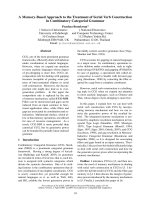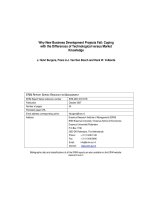The vertex trade story(eng ver)
Bạn đang xem bản rút gọn của tài liệu. Xem và tải ngay bản đầy đủ của tài liệu tại đây (1.18 MB, 17 trang )
THE VERTEX
TRADE STORY
Step by step guide for the order block strategy
Every trade has a story...
Think about it this way, would you take a trade
without a reason as to why you are taking the
trade? Sounds ridiculous right?
You need to trade with logic. Without logic - no
trade.
At Vertex we have managed to nail all the
complexities to trading smart money concepets
down to a rule based method.
Trading rule based removes the guesswork,
no rules = no trade. Simple.
Not only that, it has been narrowed down to 2
rules. These are the only two rules you need in
order to build a successful trade story.
This PDF will Break the full strategy down to a step
by step approach. Print this, download this do
whatever you want with this PDF, but this is your
go to guide should you get stuck.
Step 1: Multi time frame analysis
Analyse the overall market structure on the higher time frames Weekly daily - 4 hour.
Use the time frame you feel comfortable. Daily or the 4 hour are probably
the easiest and most utilised. The weekly time frame is a low slower but its a
good to have an idea what trend is showing you. From looking at the higher
time frames you gain an understanding regarding the overall trend and bias
of the market you are currently looking at.
Once you have done this, identify what structure you are expecting next,
whether its Higher low (HL), Lower Low (LL), Higher high (HH) or a Lower
Low (LL). This is based on your higher time frame analysis, So for example, if
you stick to using the daily time frame as your main trend indicating time
frame, Identify whether you are waiting for another of the structures listed
above. This is where a sound understanding of market structure is key!
Remember:
Higher time frames (4 hour +) - indicate our overall trend and bias - Swing
points
Lower time frames (Sub 4 hour) - Indicate intraday positions - Intraday
points
Timeframe Rules
If you struggle to decide which timeframes to use, you need to decide what
time of trader you want to be.
Use the rule of 3 to decide which time frame you are going to use.
These time frame rules are only for those who use confirmation entry.
Rule of 3: Your entry time frame - 3, skip one and use the remaining two.
As listed below:
SWING:
MONTHLY POI = 4h or daily for entry
WEEKLY POI = 1 hour or 4 hour for entry
Daily = 1h or 30m for entry
INTRADAY:
4 HOUR POI = 30m or 15m for entry
1 HOUR POI = 15m or 5m or 1m for entry
Scalping:
15M POI = 5m 1m or 30s for entry
Remember the 2 rules!
When determining if price is bullish or bearish, you need two things!
1.
2.
Impulse - An impulse which breaks a structural point
Successful retrace - The retrace which break the structure the impulse
created.
Bearish trend
Bullish trend
These Two rules will determine your trend on any time frame you are using.
So identify what trend you are in on the higher time frames to identify your
overall Bias and trend.
What are you anticipating?
Above we can see our Higher time frame Bias is bearish, within those pull
backs we have intraday bullish bias. So when following a higher time frame
bias dont be confused with the lower time frame market shift. Always
remember the bigger picture. Highest probability from a trade comes from
the alignment of multi time frames showing same trend bias. Although, price
is bullish on the lower time frame, once it reaches our Higher time frame
Order block, the lower time frame as we expect should shift in market
structure and become bearish. This is a high probability entry level.
Step 2: Identify your POI
Point of interest being our Order block. More importantly identify the order
block on the higher time frame. This is the only area you are looking to enter
from to follow trend. If you are comfortable it is the same process for counter
trend lower time frame moves.
Once you identify your OB, highlight and set an Alert at the Open of the OB.
go through multi time frames and gain and understanding of OBs which are
CLEAR that need to be mitigated. The reason we do this, so we have a rough
idea where we should expect price to react from before following our high
time frame bias. Now, if you are to follow a risk entry method, this OB
refinement is crucial as you would be setting a limit order off the refined OB
within your higher time frame OB.
For example, within a daily OB you may find a very clear 5min time frame
OB, so you may expect price to mitigate this order block before reacting. If
you chose a risk entry method, this would be your entry candle.
Make sure you understand OBs and why they exist. You have to remember
order blocks are footprints left behind from institutions. They drive price in
one direction before their desired move, but to drive price to grab liquidity,
they need to sacrifice a position, for this reason they dont use Stop losses. So
although price has a strong reaction, price returns to the order blocks so that
institutions can mitigate their losses. Without understanding this, you will
not understand the background behind this strategy and also will not have a
clear understanding of your trading.
This is key to your Trade story
Step 2: Identify your POI
When identifying Order blocks, you want to find clear Order blocks. By
clear, I mean, no wicks tickling into it. We want a clear OB and Inefficiency /
Imbalance. This signifies a strong OB.
Imbalance is key, remembers markets always have an equilibrium, 50%
buying and 50% selling. When a trader wins another trader loses. That is all
part of it. However, when there is a 100% of either buying or selling, this is
forced by institutions. Us retail traders cannot produce that move. This
indicates to us that the Institutions are active at this OB.
If there is ever an OB that you doubt, then it's not a clear OB. If it were a
clear OB, you would never question it.
Once you identify your OB, set and alert and sit on your hands.
Step 3: Go to lower time frame
Price has just entered your HTF POI and your alert has now gone off!
Great!
Now time to look to enter the trade.
Once price is there, go to a lower time frame of your choice, there is not set
time frame, no set rule about this, can use 1min, 5min or even 8min.
Whatever time frame suits your fancy it is down to you.
However, the main thing we look for is a Break of structure (BOS). A good
BOS is key. Now a BOS can be seen differently by many, at Vertex, our
mentors use a Candle body break as a BOS, not just a wick break. This can
be played around with and can be tailored to suit what you like and what
you are comfortable with.
Once you have identified a clear BOS, you need to locate your LTF OB. Again,
you want the same as before. You want a clear OB, emphasis on the word
clear. An OB with inefficiency. This is where you will look to enter your trade.
Step 4: Entry time
So you've done all that and now at the point where you have found your LTF
OB which is very clear and you're happy with it. However, if you chose a
risk entry method, the rules are the same. However, risk entries only worth
doing if momentum is in your favour.
There are a few ways you can enter,
You can set a limit order at the:
OPEN of the OB
50% of the OB
Wick trick, only if it is present.
All placed with stop loss Above the OB including spread if you are selling or
stop loss below the OB if you are Buying also including spread. If you trade
major pairs, such as EURUSD spread shouldn't be an issue.
The Open of the OB being the highest probability of trigger with the wick
trick being the lowest probability of triggering. Note, I said triggering, not
probability of the trade winning, as that probability is the same regardless.
How to decide?
Easy!
Don't get greedy with RR. Vertex mentors have a max of 5 pips for a stop
loss.
If the open provides us a 5 pip or less stop loss, then use the open. Don't try
force a high RR and be a hero. 5 pips will give you a great RR regardless.
However, what you chose as your max Stop loss size is down to you.
Step 4: Entry time Patterns
There a 2 entry patterns for a buy and sell each.
Sell entry pattern Type 1:
Once price taps into here we follow these steps:
Identify a liquidity grab which breaks the low the previous high created.
1st entry here can be the OB which created the break of the low. Following
our standard entry procedure.
2nd entry is a safer one purely as it confirms change in trend. Again using
the OB from the failed high.
Step 4: Entry time Patterns
There a 2 entry patterns for a buy and sell each.
Sell entry type 2.
Pretty simple here,
Once price taps into here we follow these steps:
Identify a BOS. Main difference here, we dont have a liquidity grab.
1st entry here can be the OB which created the break of the low. Following
our standard entry procedure.
2nd entry is a safer one purely as it confirms change in trend. Again using
the OB from the failed high.
Step 4: Entry time Patterns
There a 2 entry patterns for a buy and sell each.
Buy entry type 1.
Pretty simple here,
Once price taps into here we follow these steps:
Identify a liquidity grab which breaks the low the previous high created.
1st entry here can be the OB which created the break of the low. Following
our standard entry procedure.
2nd entry is a safer one purely as it confirms change in trend. Again using
the OB from the failed high.
Step 4: Entry time Patterns
There a 2 entry patterns for a buy and sell each.
Buy entry type 2.
Pretty simple here,
Once price taps into here we follow these steps:
Identify a BOS. Main difference here, we dont have a liquidity grab.
1st entry here can be the OB which created the break of the low. Following
our standard entry procedure.
2nd entry is a safer one purely as it confirms change in trend. Again using
the OB from the failed high.
Step 5: Trade Management
So you are in a trade! Great!
You followed your plan.
Now the hard bit. Management.
This is subjective to you. If you're following the higher time frame Bias, you
would expect a new structure to form, such as new low or new high. You can
set targets, at previous structure points, such as the recent low or recent
high, or you can simply trail a trade. How you trail is down to you, whether
you chose an aggressive method or not. Trailing may show to be effective, as
you may get a full swing trade from your entry if trailed conservatively. But I
will leave that decision to you.
If you want to trade counter trend on the lower time frames, go for it!
However, dont forget the bigger picture!!
Facts
You are going to lose! Loses will happen over the course of your trading
career. Accept it. Sooner you accept it, easier it will be. Does not mean the
strategy is rubbish or it doesn't work for you, it only failed this time. Also,
sometimes, it may not be a human error, the strategy may fail you. So do
not always blame yourself.
Don't chase a trade or force one. Utilize alerts and practice sitting on your
hands till price comes to your POI.
So you have won several trades in a row and you get excited and feel
invincible. Do not let the winners get to you as you are also trading with
emotion which will cloud your judgement.
Manage your risk. If a trade has you sweating and worrying, you have
risked too much. Risk an amount you comfortable risking. An amount that
does not make you think twice.
Focus on yourself, if someone else is doing better, who cares!? You shouldn't.
You focus on you and your own self growth.
Trading is not easy, regardless of how easy others make it seem. Accept this
fact.
Have a plan and stick to it. Which is why we developed this guide. If there is
one step missing, dont trade it. Wait! Opportunities are always around the
corner.
One more rule....
KEEP
IT
SIMPLE









